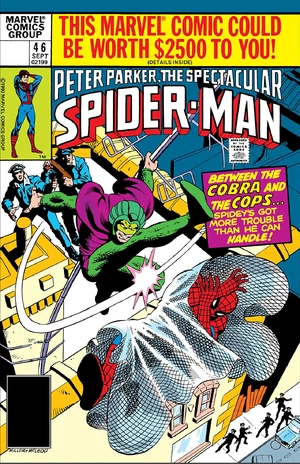
A Frank Miller cover, with the wonderful sense of motion and grit that came along with Miller art when he was at the top of his game. What’s better than that?

A fantastic splash page! I first saw this probably a quarter of a century ago, and yet when I flipped open to it for this review, I still remembered everything about it. Modern comic book storytelling doesn’t allow for that many word boxes anymore—the current style is to allow the art to establish mood, not words—but Roger Stern is one of the best of all time, and he knew how to script an intro page. Look how he even admits that Rikers Island is “not in the best of shape,” foreshadowing the jailbreak that’s coming in the next few pages. And Mike Zeck puts his typically larger-than-life rendition of Spider-Man looming over it all—telling us that yes, the prison is vulnerable, but there is still a protector for this City.
God I love 1980s Marvel.

Okay, so there’s the break. Cobra contorts his way out of the barred window, ignoring the plea of Mr. Hyde to help him break out, too. Cobra doesn’t. And this will matter when Roger Stern takes over Amazing Spider-Man, because we’ll get one of the best two-part stories of all time when we see Hyde’s revenge–Amazing Spider-Man #229-230.
Moving to Peter Parker, we watch him spend his morning at the Daily Globe and his afternoon teaching students…
… and then, worn out at the end of the day, he wants to unwind.

And that means Spider-Man. Yet another reason why the 1980s was the best time for Marvel: Spider-Man loved being Spider-Man. There was nothing tragic about it. And putting on the costume was a way for him to engage with the world—not place himself above it, or fly off into space. He was down here with all of us, doing what we did during the day, but he had those tremendous powers that enabled him to cut loose—like every teenage comic book reader wanted for himself.

Inevitably, he beats up Cobra but the police, who hate his interference, let Cobra get away.
So much greatness here, but the actual hero-versus-villain battle is basically a three-page afterthought.

